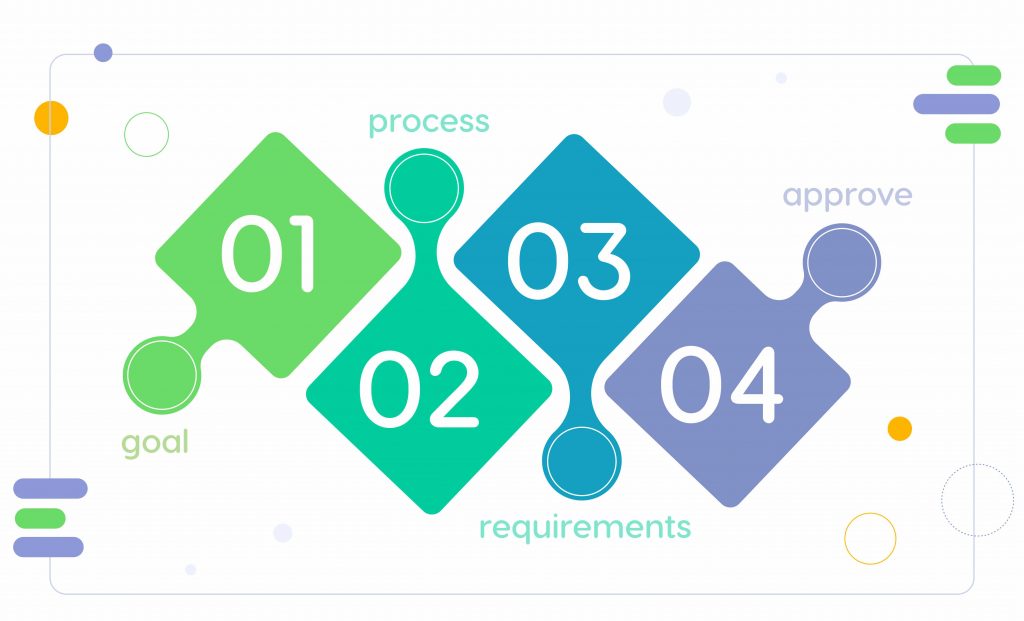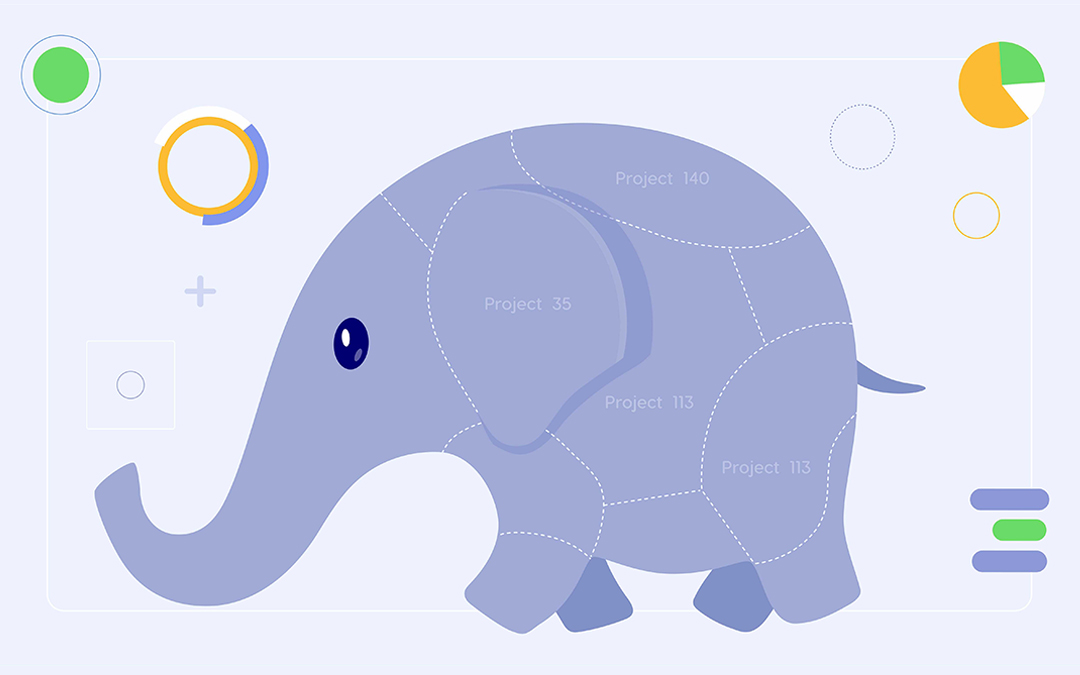We all know how difficult it can be to approach a large new endeavor. For example, standing in the middle of a messy house may seem overwhelming, but if you tidy the rooms one by one, the cleaning up will turn out to be quite manageable.
The same is true with the project management process – the final project outcome should be divided into smaller pieces of work (deliverables), each of which will contribute to achieving the end project goal. Read further to get a full picture of project deliverables and learn how to identify and manage them efficiently.
What Are Project Deliverables?
A project deliverable refers to the output obtained upon completion of a project (or a particular piece of work) – a product, a service, or a capability. To be considered deliverables for a project, its output should meet the following requirements:
- it’s the result of purposeful activity;
- it’s agreed with all project stakeholders;
- it fits into the baselined project scope;
- it has a specific role in achieving the final project goal.
Project deliverables aren’t the same as milestones, though they both refer to a particular result of work. While a project deliverable is the output of project activities, a milestone indicates a checkpoint in the project flow: e.g., the completion of a critical task, the end of a project phase, etc. Project milestones aren’t components of project objectives but serve as a tool for tracking project progress.
Examples of deliverables in project management
Examples of project deliverables vary depending on the industry and specifics of a project. For example, aerospace and defense projects can come up with prototypes of defense equipment or a new aircraft. In software development projects, it can be documentation with the results of software testing, a software code, or a functioning software product. As for manufacturing projects, deliverables can be finished products, their prototypes, production plans and schedules, etc. Deliverables for marketing teams include writing pieces of content, launching e-mail campaigns, creating design samples, and more.
Why is it important to identify deliverables?
Determining deliverables in project management is essential for the following reasons.
- It allows project team members to see a comprehensive picture of the project scope they need to accomplish.
- It breaks down a project goal into smaller components, which makes project work more manageable.
- Identifying deliverables and tracking their completion helps manage stakeholder expectations: it makes it easier for stakeholders and clients to understand how the project progresses.
- Project deliverables become components of a work breakdown structure – a visual representation of the project scope, which is the input for further project processes.
Finally, the deliverables help project managers form a “skeleton” for the project work and provide a clear understanding of how to achieve project goals and objectives.
Now, let’s examine the main types of project deliverables.
Types of Deliverables in Project Management
Project management deliverables fall into the following categories.
Tangible deliverables
Tangible deliverables are physical and digital objects or measurable outputs of a project. Tangible project deliverables examples are physical products like prototypes, printed issues, buildings, machines, etc. They can also be digital, e.g., adding a new feature to a product. The main characteristic of a tangible deliverable is that it represents the concrete output of the work performed.
Intangible deliverables
Intangible deliverables are conceptual outcomes obtained upon completing a piece of project work. Examples of intangible deliverables of a project are increasing customer satisfaction, developing a marketing strategy, getting new clients, etc.
Product deliverables
Product deliverables refer to the final project output (a product, service, capability) and are client-oriented. They usually come in the form of a product or service and can be physical or digital, e.g., physical products, applications, built infrastructure, prototypes, etc.
Process deliverables
This type of deliverables denote project-related outputs or interim results that help achieve the product deliverable and are essential for stakeholders. In contrast to product deliverables, they focus on the stages of a project. They can be project plans, schedules, status reports, budget reports, etc. Process deliverables play an essential role in tracking project progress and keeping it on the right track.
Internal deliverables
Internal project deliverables are project outputs meant for internal use within a company or a project team; they aren’t intended for customers. These can be products or services for an organization’s purposes to ensure proper project execution. Examples of internal deliverables are project documentation, project status reports, meeting minutes, training materials, etc.
External deliverables
External project deliverables indicate the output (products or services) created for customers or other external stakeholders. They can be both tangible and intangible outputs. Examples of external deliverables include products, software, documentation, or training but their main focus is on external clients.
Now that the key types of deliverables are clear, it’s time to discover the essential steps of identifying project outputs.

Identifying Project Deliverables: 4 Steps to Follow
To ensure the achievement of the final project goal, you should determine the interim deliverables in a project, gather requirements for them, and ensure their completion. Let’s review these steps in more detail.
Step 1. Start from the project goal.
If you’ve created a work breakdown structure of your project scope, you will find the main deliverables in it. If not, go backward from the final result you expect to achieve upon project completion (the final deliverable) and break it down into smaller components. The following information will help you do that:
- what should be achieved upon project completion (what customers want);
- the integral parts of the final output;
- the importance of each piece for achieving the project goal;
- the cost and time required for completing each part.
A project scope statement is a document that not only outlines project objectives but presents an overview of all project deliverables.
Step 2. Identify requirements for each deliverable.
This step aims to determine what will make the deliverable acceptable to stakeholders. Requirements should be as accurate as possible – ambiguity can lead to rework, delay, and budget overrun. The following points should be considered when determining the demands:
- the key stakeholders who will approve the deliverable and their expectations regarding it;
- whether these requirements fit into the approved project scope and budget;
- historical data on similar deliverables (if available);
- the industry standard for this kind of deliverables;
- quality criteria for this deliverable.
Remember that requirements can (and will) change as the project progresses, but you should manage them to avoid scope creep.
Read more: Changing Requirements in Project Management: How to Stay on Track
Step 3. Determine process deliverables.
As we’ve mentioned earlier, process deliverables help complete key deliverables within a project, so they need to be identified, too. Project management documents (e.g., a project management plan, a project charter, or project schedule document) are examples of process deliverables. When determining them, you need to decide on the following things:
- what process deliverables are required to complete the final one;
- employees responsible for completing each process deliverable;
- ways of their tracking and management;
- timelines for completing process deliverables;
- stakeholders who will approve them.
Step 4. Approve the deliverables.
As soon as all the would-be achievements are determined, they should be approved by corresponding stakeholders. After that, the project team members should familiarize themselves with all deliverables, requirements for them, and the change control process (to know how to deal with change requests).
Step 5. Monitor progress.
Regular monitoring of progress ensures the completion of each deliverable and facilitates overall project success. In addition, it’s a good idea to assess resource performance to make sure that your people cope well with the assigned scope of work, which is especially relevant in a multi-project environment. You can use project management tools to simplify this task.
Let’s consider how to ensure the completion of deliverables, and what role a project management software plays in their management.
Managing Project Deliverables: How a Project Management Tool Helps
As project management deliverables have been determined and the team members have started work, a project manager needs to keep track of all these activities to ensure their successful completion. Achieving good results becomes possible thanks to assigning tasks to the right people, prioritizing project activities, identifying risks and problems, and more.
When there are multiple projects running in a company, all of these deliverables can turn into a mess, and ensuring their successful completion will become extremely challenging. The right software solution can help a project manager clear things up. Let’s review the capabilities of Epicflow to get a better understanding of how a resource management tool helps manage deliverables and ensure their successful completion.
Epicflow is a multi-project resource management solution that contributes to the efficient utilization of shared resources in a multi-project environment and the successful delivery of all projects in the environment. How does it help manage project deliverables?
Clear workflow organization
- In Epicflow, project work is divided into phases (sprints, releases, phases); logically related tasks are grouped into summaries.
- You can set milestones that will help track project progress.
- Resources working in the same domain are united into resource groups or can be grouped in cross-functional teams.
- The focus of project work is on highest-priority projects and tasks.
Task management
Successful accomplishment of project tasks is the basis for completing a deliverable. But when there is a pile of tasks belonging to different projects, it’s impossible for each team member to define the most important ones at their own discretion. Epicflow’s prioritization mechanism will help each resource (as well as a resource group) understand the order of completing their assignments, starting from the one with the highest priority.
Resource management
Here are some capabilities of Epicflow’s resource management features:
- It balances employees’ workload: the Future Load Graph predicts both overload and idleness so that a project manager can adjust the workload to ensure smooth workflow across all projects in the portfolio and avoid bottlenecks.
- It helps manage team members’ competences: add, edit, and remove them and use this data for efficient resource allocation.
- It helps assign the right people to the right tasks based on capacity, availability, and competences.
Tracking progress
Epicflow makes it possible to track project progress and resource performance so that a project manager and stakeholders can be aware of each project’s and the whole portfolio’s “health”. If there are problems in the workflow, Epicflow will show their causes.
Testing project management decisions
Making the right decision is challenging when you don’t know exactly what consequences it will have. But with Epicflow’s What-if Analysis, you can try out different changes to the project environment, analyze their impact, and choose the most reasonable option. Also, you can run scenarios to forecast risks, which will help you make the right decisions to address them.
This list isn’t exhaustive, and Epicflow has many more features to offer for seamless project orchestration and efficient resource management. Learn more about its capabilities by scheduling a demo with our specialist.
Final Words
Let’s summarize the key points of the article.
- A project deliverable is an output produced upon completion of a piece of project work or the whole project — e.g., a product, a service, or a capability.
- Identifying project management deliverables helps project managers create the foundation for project work and break it down into clear and manageable stages.
- There can be the following types of project deliverables: tangible and intangible, internal and external, related to a process or a product.
- Determining project deliverables requires the following steps: identifying the project goal and dividing it into smaller manageable components; determining requirements for each deliverable; establishing process deliverables, and approving all of them.
- Effective project management tools help manage project deliverables by setting priorities, providing real-time monitoring of progress and performance, and assisting in decision-making.
References
- What Are Project Deliverables? Complete Guide. Retrieved from: https://www.knowledgehut.com/blog/project-management/what-are-deliverables-for-project

